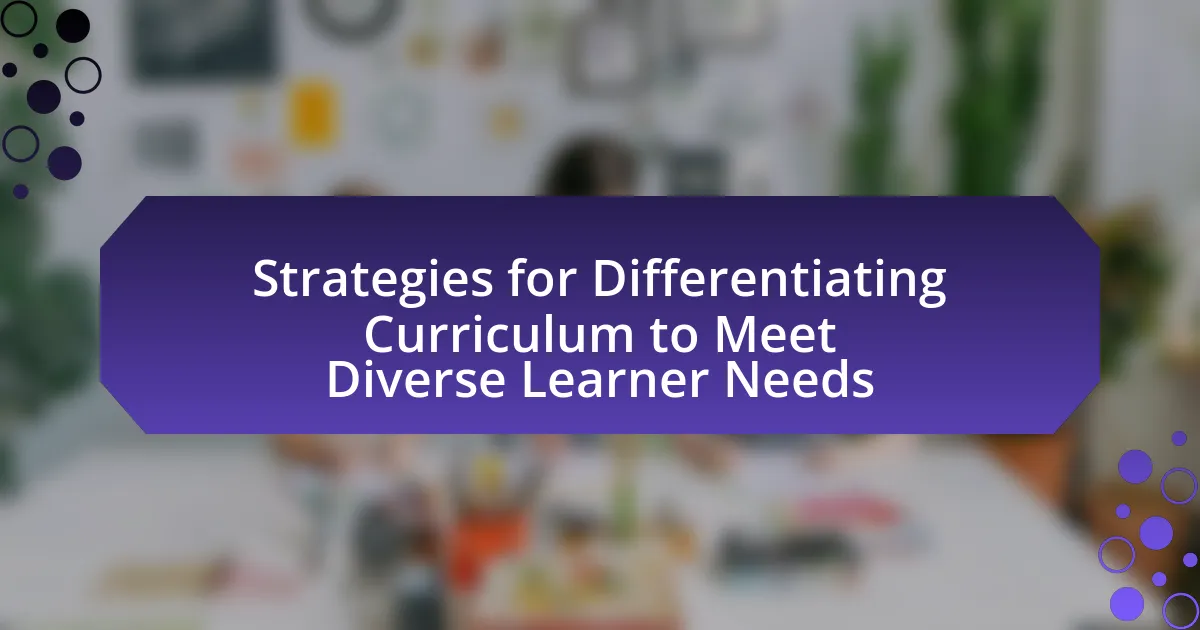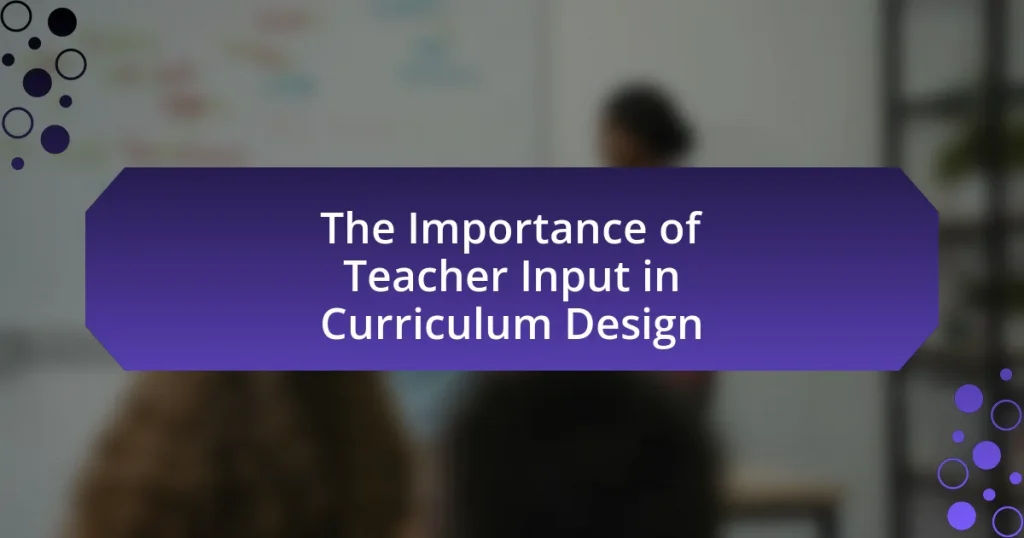The article focuses on strategies for differentiating curriculum to meet the diverse needs of learners. It outlines key approaches such as flexible grouping, tiered assignments, and varied instructional methods that cater to different learning styles and readiness levels. The discussion emphasizes the importance of recognizing student variability, providing multiple pathways for learning, and adjusting content, process, and product based on individual assessments. Additionally, it highlights the role of formative assessment, collaboration among educators, and the integration of technology in enhancing differentiation efforts, ultimately supporting improved student engagement and academic achievement.

What are Strategies for Differentiating Curriculum to Meet Diverse Learner Needs?
Strategies for differentiating curriculum to meet diverse learner needs include flexible grouping, tiered assignments, and varied instructional methods. Flexible grouping allows educators to form dynamic groups based on students’ readiness, interests, or learning profiles, facilitating targeted instruction. Tiered assignments enable teachers to create tasks at varying levels of difficulty, ensuring that all students engage with the content at an appropriate challenge level. Varied instructional methods, such as incorporating visual, auditory, and kinesthetic learning activities, cater to different learning styles and preferences. Research by Tomlinson (2001) in “How to Differentiate Instruction in Mixed-Ability Classrooms” supports these strategies, demonstrating that differentiated instruction enhances student engagement and achievement across diverse learning needs.
How do these strategies address the varying needs of learners?
These strategies address the varying needs of learners by providing tailored instructional approaches that accommodate different learning styles, abilities, and interests. For instance, differentiated instruction allows educators to modify content, process, and product based on individual student assessments, ensuring that each learner engages with material at an appropriate level. Research by Tomlinson (2001) highlights that such differentiation leads to improved student engagement and achievement, as it aligns educational practices with the diverse cognitive and emotional needs of students.
What are the key principles behind curriculum differentiation?
The key principles behind curriculum differentiation include recognizing student variability, providing multiple pathways for learning, and adjusting content, process, and product based on individual needs. Recognizing student variability involves understanding that learners have diverse backgrounds, interests, and readiness levels, which necessitates tailored instructional strategies. Providing multiple pathways for learning means offering various methods and resources to engage students, such as visual aids, hands-on activities, and technology integration. Adjusting content, process, and product ensures that educators modify what students learn, how they learn it, and how they demonstrate their understanding, thereby fostering an inclusive learning environment that meets the needs of all students. These principles are supported by research indicating that differentiated instruction can lead to improved student engagement and achievement.
How does understanding learner diversity influence curriculum design?
Understanding learner diversity significantly influences curriculum design by ensuring that educational content is tailored to meet the varied needs, backgrounds, and learning styles of students. This approach allows educators to create inclusive learning environments that accommodate different abilities, cultural perspectives, and interests, thereby enhancing student engagement and achievement. Research indicates that differentiated instruction, which is informed by an understanding of learner diversity, leads to improved academic outcomes, as it addresses the unique strengths and challenges of each learner. For instance, a study by Tomlinson (2001) highlights that when teachers adapt their curriculum based on student diversity, they can foster a more equitable learning experience, ultimately promoting better retention and understanding of the material.
Why is it important to differentiate curriculum?
Differentiating curriculum is important because it addresses the diverse learning needs of students, ensuring that all learners can engage with the material effectively. By tailoring instruction to various learning styles, abilities, and interests, educators can enhance student motivation and achievement. Research indicates that differentiated instruction leads to improved academic outcomes; for instance, a study published in the “Journal of Educational Psychology” by Tomlinson and Strickland (2005) found that students in differentiated classrooms showed greater gains in standardized test scores compared to those in traditional settings. This approach fosters an inclusive learning environment where every student has the opportunity to succeed.
What impact does differentiation have on student engagement?
Differentiation significantly enhances student engagement by tailoring learning experiences to meet individual needs and preferences. When educators implement differentiated strategies, such as varied instructional methods and personalized learning paths, students are more likely to feel motivated and invested in their education. Research by Tomlinson (2001) indicates that differentiated instruction leads to increased student interest and participation, as it allows learners to connect content to their own experiences and strengths. This personalized approach fosters a sense of ownership over learning, which is crucial for maintaining high levels of engagement.
How does curriculum differentiation support academic achievement?
Curriculum differentiation supports academic achievement by tailoring educational experiences to meet the diverse needs of students. This approach allows educators to modify content, process, and products based on individual learning styles, readiness levels, and interests, which enhances engagement and understanding. Research indicates that differentiated instruction can lead to improved student performance; for instance, a study by Tomlinson (2001) found that students in differentiated classrooms showed higher levels of achievement compared to those in traditional settings. By addressing the unique strengths and challenges of each learner, curriculum differentiation fosters a more inclusive and effective learning environment, ultimately contributing to better academic outcomes.

What are the different approaches to curriculum differentiation?
Curriculum differentiation encompasses various approaches designed to address the diverse learning needs of students. These approaches include content differentiation, process differentiation, product differentiation, and learning environment differentiation.
Content differentiation involves modifying what students learn, such as providing varied reading materials or resources tailored to different skill levels. Process differentiation focuses on how students engage with the material, allowing for varied instructional strategies like small group work or independent study. Product differentiation allows students to demonstrate their understanding through different formats, such as projects, presentations, or written assignments. Lastly, learning environment differentiation adjusts the physical or social context in which learning occurs, such as flexible seating arrangements or collaborative learning spaces.
Research supports these approaches, indicating that differentiated instruction can lead to improved student engagement and achievement, as highlighted in studies by Tomlinson (2001) and the National Center for Learning Disabilities.
How can teachers implement differentiated instruction in the classroom?
Teachers can implement differentiated instruction in the classroom by tailoring their teaching methods and materials to accommodate the diverse learning needs of students. This can be achieved through various strategies such as flexible grouping, where students are grouped based on their skill levels or interests, allowing for targeted instruction. Additionally, teachers can modify assignments and assessments to match individual learning profiles, ensuring that all students can engage with the content at their own level. Research indicates that differentiated instruction can lead to improved student outcomes, as it addresses the varying readiness levels, interests, and learning profiles of students, thereby fostering a more inclusive learning environment.
What role does formative assessment play in differentiation?
Formative assessment plays a crucial role in differentiation by providing ongoing feedback that informs instructional adjustments tailored to individual student needs. This type of assessment allows educators to identify students’ strengths and weaknesses in real-time, enabling them to modify teaching strategies and learning activities accordingly. Research indicates that formative assessments can lead to improved student outcomes, as they foster a responsive learning environment where instruction is aligned with each learner’s progress and understanding. For instance, a study by Black and Wiliam (1998) found that effective formative assessment practices significantly enhance student achievement by promoting personalized learning experiences.
How can flexible grouping enhance learning experiences?
Flexible grouping enhances learning experiences by allowing educators to tailor instruction to meet the diverse needs of students. This approach enables teachers to form groups based on students’ skills, interests, or learning profiles, facilitating targeted support and collaboration. Research indicates that flexible grouping can lead to improved academic outcomes; for instance, a study by Tomlinson et al. (2003) found that differentiated instruction, including flexible grouping, significantly increased student engagement and achievement in diverse classrooms. By adapting group compositions regularly, educators can foster a more inclusive environment that promotes peer learning and accommodates varying learning paces.
What types of differentiation can be applied to curriculum?
Curriculum differentiation can be categorized into four main types: content differentiation, process differentiation, product differentiation, and learning environment differentiation. Content differentiation involves varying the materials and resources provided to students based on their readiness levels, interests, or learning profiles. Process differentiation refers to the different ways students engage with the material, which may include varied instructional strategies or learning activities tailored to diverse learning styles. Product differentiation allows students to demonstrate their understanding through various formats, such as projects, presentations, or written assignments, reflecting their individual strengths and preferences. Lastly, learning environment differentiation focuses on modifying the physical or social environment to enhance learning, such as flexible seating arrangements or collaborative group work. These types of differentiation are supported by educational research, which indicates that tailored instructional approaches can significantly improve student engagement and achievement.
How can content differentiation be effectively utilized?
Content differentiation can be effectively utilized by tailoring instructional materials and activities to meet the diverse needs of learners. This approach involves assessing students’ readiness, interests, and learning profiles to provide varied content that engages each learner. Research indicates that differentiated instruction can lead to improved student outcomes; for instance, a study by Tomlinson (2001) found that students in differentiated classrooms showed higher levels of engagement and achievement compared to those in traditional settings. By implementing strategies such as tiered assignments, flexible grouping, and choice boards, educators can create a more inclusive learning environment that fosters individual growth and success.
What strategies exist for differentiating process and product?
Differentiating process and product involves employing strategies that cater to diverse learner needs while maintaining curriculum integrity. One effective strategy is to utilize varied instructional methods, such as tiered assignments, which allow students to engage with content at different levels of complexity based on their readiness. Another strategy is to implement flexible grouping, where students collaborate in diverse teams that change according to the task, fostering peer learning and accommodating different learning styles. Additionally, offering choices in assessment formats—such as projects, presentations, or written reports—enables students to demonstrate their understanding in ways that align with their strengths. Research indicates that these strategies enhance student engagement and achievement by addressing individual learning preferences and needs.

What challenges do educators face in differentiating curriculum?
Educators face several challenges in differentiating curriculum, primarily due to varying student needs, limited resources, and time constraints. The diversity in student learning styles, abilities, and backgrounds complicates the creation of tailored instructional strategies. Additionally, many educators lack access to adequate training and professional development focused on differentiation techniques, which hinders their ability to effectively implement these strategies. Research indicates that 70% of teachers report feeling unprepared to differentiate instruction, highlighting the need for targeted support and resources to address this gap.
How can teachers overcome common barriers to differentiation?
Teachers can overcome common barriers to differentiation by implementing flexible grouping strategies, utilizing formative assessments, and providing targeted professional development. Flexible grouping allows teachers to tailor instruction based on students’ varying needs, enabling them to work in diverse groups that promote collaboration and peer learning. Formative assessments help educators identify individual student strengths and weaknesses, allowing for timely adjustments in teaching methods and materials. Additionally, targeted professional development equips teachers with the necessary skills and strategies to effectively differentiate instruction, as evidenced by research indicating that ongoing training significantly enhances teachers’ ability to meet diverse learner needs.
What resources are available to support differentiated curriculum efforts?
Resources available to support differentiated curriculum efforts include professional development programs, instructional materials, and technology tools. Professional development programs, such as those offered by the Association for Supervision and Curriculum Development (ASCD), provide educators with strategies and frameworks for implementing differentiation effectively. Instructional materials, including differentiated lesson plans and assessment tools from organizations like Teachers Pay Teachers, allow educators to tailor content to diverse learning needs. Additionally, technology tools such as Google Classroom and adaptive learning platforms like DreamBox Learning facilitate personalized learning experiences by adjusting content based on individual student performance. These resources collectively enhance the ability of educators to meet the varied needs of their students.
How can professional development enhance teachers’ differentiation skills?
Professional development can enhance teachers’ differentiation skills by providing targeted training and resources that equip educators with effective strategies to meet diverse learner needs. Research indicates that professional development programs focused on differentiation lead to improved instructional practices, as teachers learn to tailor their approaches based on students’ varying abilities, interests, and learning styles. For example, a study by Tomlinson and Strickland (2005) highlights that teachers who engage in ongoing professional development are more adept at implementing differentiated instruction, resulting in higher student engagement and achievement. This evidence supports the assertion that structured professional development is crucial for enhancing teachers’ ability to differentiate effectively in the classroom.
What best practices can educators adopt for effective differentiation?
Educators can adopt several best practices for effective differentiation, including assessing student readiness, interests, and learning profiles to tailor instruction. By utilizing formative assessments, educators can identify individual student needs and adjust their teaching strategies accordingly. Research indicates that differentiated instruction can lead to improved student engagement and achievement, as evidenced by a study published in the “Journal of Educational Psychology,” which found that students in differentiated classrooms showed higher levels of motivation and academic success compared to those in traditional settings. Additionally, incorporating flexible grouping allows educators to create dynamic learning environments that cater to diverse learner needs, fostering collaboration and peer learning.
How can collaboration among educators improve differentiation strategies?
Collaboration among educators can significantly enhance differentiation strategies by allowing for the sharing of diverse teaching methods and resources. When educators work together, they can pool their expertise to develop tailored instructional approaches that address the varied learning needs of students. Research indicates that collaborative professional development leads to improved teaching practices; for instance, a study by Vescio, Ross, and Adams (2008) found that collaborative learning among teachers resulted in increased student achievement and engagement. By exchanging insights and strategies, educators can create a more inclusive learning environment that effectively meets the needs of all learners.
What role does technology play in facilitating curriculum differentiation?
Technology plays a crucial role in facilitating curriculum differentiation by providing personalized learning experiences tailored to individual student needs. Through adaptive learning platforms, educators can assess students’ strengths and weaknesses in real-time, allowing for customized content delivery that aligns with each learner’s pace and style. For instance, tools like Google Classroom and Khan Academy enable teachers to assign differentiated tasks based on student performance data, ensuring that all learners engage with material that is appropriately challenging. Research indicates that technology-enhanced differentiation can lead to improved student outcomes, as evidenced by a study published in the Journal of Educational Technology & Society, which found that students using adaptive learning technologies showed significant gains in academic achievement compared to those in traditional settings.
What practical tips can educators use to differentiate curriculum effectively?
Educators can differentiate curriculum effectively by employing flexible grouping strategies, which allow students to work in varied configurations based on their learning needs. This approach enables teachers to tailor instruction to diverse skill levels and interests, fostering engagement and understanding. Research indicates that flexible grouping can enhance student achievement, as it promotes collaboration and peer learning (Tomlinson, 2001). Additionally, educators should utilize tiered assignments that provide varying levels of complexity, ensuring that all students are challenged appropriately while still working towards the same learning objectives. This method has been shown to support mastery of content across different learner profiles (Tomlinson, 2001). Lastly, incorporating student choice in assignments empowers learners to take ownership of their education, which can lead to increased motivation and investment in their learning process.



